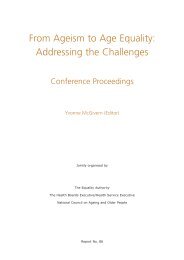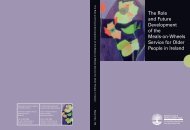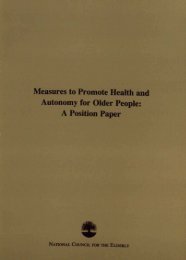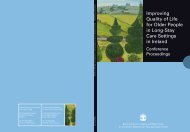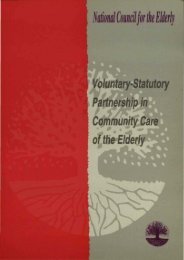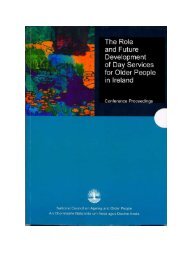Improving Quality of Life for Older People in Long-Stay Care ...
Improving Quality of Life for Older People in Long-Stay Care ...
Improving Quality of Life for Older People in Long-Stay Care ...
- No tags were found...
Create successful ePaper yourself
Turn your PDF publications into a flip-book with our unique Google optimized e-Paper software.
was that they had a choice. In some study sites staff were able to facilitate residentchoice while others, which appeared to have similar staff resources and facilities,could not. Observation with<strong>in</strong> the sites <strong>in</strong>dicated that some sites were fully committedto the organisational change required to facilitate choice and others were not.In some places, what Kane (2001) refers to as the ‘unshakable rout<strong>in</strong>es <strong>of</strong> theorganisation’ militates aga<strong>in</strong>st the expression <strong>of</strong> personal autonomy. The tensionbetween rout<strong>in</strong>e and personalised care was evident <strong>in</strong> all <strong>of</strong> the study sites.Some residents reported that they felt at ‘home’ <strong>in</strong> residential care and that theywere able to cont<strong>in</strong>ue to live their life as normal. The experience <strong>of</strong> residents wholived <strong>in</strong> facilities where rout<strong>in</strong>e dom<strong>in</strong>ated was very different. They felt constra<strong>in</strong>edby the ‘rules’ and feared be<strong>in</strong>g considered a ‘troublemaker’. Best practice wouldsuggest that residents’ lives should be as similar as possible to the lives they wouldchoose to live at home. <strong>Quality</strong> care requires the collection <strong>of</strong> prior <strong>in</strong><strong>for</strong>mationon residents’ normal rout<strong>in</strong>es and preferences. Residents need to be asked abouttheir likes and dislikes. Collect<strong>in</strong>g this <strong>in</strong><strong>for</strong>mation is mere tokenism, however,unless greater flexibility is built <strong>in</strong>to the rout<strong>in</strong>e to enable residents’ choices to bemet. This should <strong>in</strong>clude extend<strong>in</strong>g d<strong>in</strong><strong>in</strong>g times, meet<strong>in</strong>g bath<strong>in</strong>g preferences andaccommodat<strong>in</strong>g preferred times <strong>of</strong> ris<strong>in</strong>g and go<strong>in</strong>g to bed.It would seem, there<strong>for</strong>e, that one <strong>of</strong> the most significant factors to impact on aresident’s quality <strong>of</strong> life is the care philosophy <strong>of</strong> the unit <strong>in</strong> which they live. Thisdictates the general approach to care, staff attitudes, care priorities and residentautonomy. It, there<strong>for</strong>e, has a tangible impact on residents’ quality <strong>of</strong> life. In somefacilities residents felt empowered, whereas <strong>in</strong> others residents appeared powerlessand constra<strong>in</strong>ed. The current trend <strong>in</strong> gerontological nurs<strong>in</strong>g is a move to a moreperson-centred service. A person-centred service is one which is based on consultation,autonomy, choice, <strong>in</strong>dividual care and resident <strong>in</strong>volvement <strong>in</strong> decision-mak<strong>in</strong>g(McCormack, 2003; Clarke et al., 2003; Davies et al., 1999). If the services are tobecome more person-centred, it is important that these concepts drive the philosophy<strong>of</strong> facilities and steps are taken to embed these concepts <strong>in</strong>to the way <strong>in</strong> whichcare is delivered. The f<strong>in</strong>d<strong>in</strong>gs <strong>of</strong> this research would suggest that a move toperson-centred care will require a fundamental shift <strong>in</strong> the way <strong>in</strong> which servicesare managed and delivered. The <strong>in</strong>ternational literature would suggest that thenurse manager is key to mak<strong>in</strong>g this shift; many studies have found that the nursemanager has a powerful role <strong>in</strong> shap<strong>in</strong>g the philosophy <strong>of</strong> the facility/unit and <strong>in</strong>lead<strong>in</strong>g change (Wright and McCormack, 2001; Redfern et al., 2002; Kitson, 1991).Management tra<strong>in</strong><strong>in</strong>g and cont<strong>in</strong>u<strong>in</strong>g education <strong>for</strong> staff should focus on develop<strong>in</strong>gan understand<strong>in</strong>g <strong>of</strong> quality <strong>of</strong> life issues and putt<strong>in</strong>g <strong>in</strong> place person-centredmodels <strong>of</strong> care with<strong>in</strong> facilities. All staff need to prioritise quality <strong>of</strong> life objectivesif they are to provide good quality <strong>of</strong> care <strong>for</strong> residents.219







